Page 3 out of 35 results
Sort by
Newest Business Analytics: Data Analysis summaries
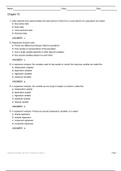
-
Chapter 10: Business Analytics_ Data Analysis _ Decision Making 5th Edition Albright
- Exam (elaborations) • 33 pages • 2020
-
- £6.96
- 4x sold
- + learn more
1. Data collected from approximately the same period of time from a cross-section of a population are called: a. time series data b. linear data c. cross-sectional data d. historical data 2. Regression analysis asks: a. if there are differences between distinct populations b. if the sample is representative of the population c. how a single variable depends on other relevant variables d. how several variables depend on each other 3. In regression analysis, the variables used to help explain or...
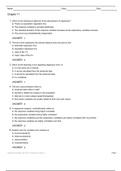
-
Chapter: 11 Business Analytics_ Data Analysis _ Decision Making 5th Edition Albright
- Exam (elaborations) • 33 pages • 2020
-
- £6.96
- 4x sold
- + learn more
1. Which of the following is not one of the assumptions of regression? a. There is a population regression line b. The response variable is normally distributed c. The standard deviation of the response variable increases as the explanatory variables increase d. The errors are probabilistically independent 2. The error term represents the vertical distance from any point to the a. estimated regression line b. population regression line c. value of the Y’s d. mean value of the X’s 3. Which ...
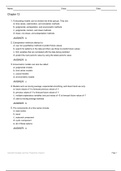
-
Chapter 12: Business Analytics_ Data Analysis _ Decision Making 5th Edition Albright
- Exam (elaborations) • 35 pages • 2020
-
- £6.96
- 2x sold
- + learn more
1. Forecasting models can be divided into three groups. They are: a. time series, optimization, and simulation methods b. judgmental, extrapolation, and econometric methods c. judgmental, random, and linear methods d. linear, non-linear, and extrapolation methods 2. Extrapolation methods attempt to: a. use non-quantitative methods to predict future values b. search for patterns in the data and then use those to predict future values c. find variables that are correlated with the data being pred...
Do you also write (revision) notes yourself? Put them up for sale and earn every time your document is purchased.
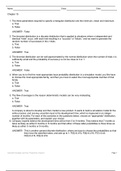
-
Chapter 15: Business Analytics_ Data Analysis _ Decision Making 5th Edition Albright
- Exam (elaborations) • 31 pages • 2020
-
- £6.96
- 3x sold
- + learn more
1. The three parameters required to specify a triangular distribution are the minimum, mean and maximum. a. True b. False 2. The binomial distribution is a discrete distribution that is applied to situations where n independent and identical “trials” occur, with each trial resulting in a “success” or “failure,” and we want to generate the random number of successes in the n trials. a. True b. False 3. The binomial distribution can be well approximated by the normal distribution whe...
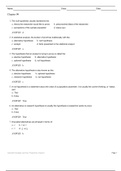
-
Chapter 9: Business Analytics_ Data Analysis _ Decision Making 5th Edition Albright
- Exam (elaborations) • 34 pages • 2020
-
- £6.14
- 2x sold
- + learn more
1. The null hypothesis usually represents the: a. theory the researcher would like to prove. b. preconceived ideas of the researcher c. perceptions of the sample population d. status quo 2. In statistical analysis, the burden of proof lies traditionally with the: a. alternative hypothesis b. null hypothesis c. analyst d. facts presented to the statistical analyst 3. The hypothesis that an analyst is trying to prove is called the: a. elective hypothesis b. alternative hypothesis c. optional hyp...
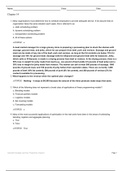
-
Chapter 14: Business Analytics_ Data Analysis _ Decision Making 5th Edition Albright
- Exam (elaborations) • 64 pages • 2020
-
- £7.37
- 2x sold
- + learn more
1. Many organizations must determine how to schedule employees to provide adequate service. If we assume that an organization faces the same situation each week, this is referred to as a. static scheduling problem b. dynamic scheduling problem c. transportation scheduling problem d. All of these options A meat market manager for a large grocery store is preparing a processing plan to stock the shelves with sausage, ground meat, and jerky, which he can prepare from beef, pork and venison. Sausag...
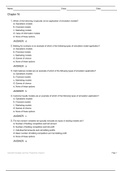
-
Chapter 16: Business Analytics_ Data Analysis _ Decision Making 5th Edition Albright
- Exam (elaborations) • 32 pages • 2020
-
- £7.37
- 2x sold
- + learn more
1. Which of the following is typically not an application of simulation models? a. Operations models b. Financial models c. Marketing models d. Value of Information models e. None of these options 2. Bidding for contracts is an example of which of the following types of simulation model application? a. Operations models b. Financial models c. Marketing models d. Games of chance e. None of these options 3. Cash balance models are an example of which of the following types of simulation applicat...
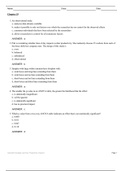
-
Chapter 19: Business Analytics_ Data Analysis _ Decision Making 5th Edition Albright
- Exam (elaborations) • 4 pages • 2020
-
- £7.37
- 4x sold
- + learn more
1. An observational study: a. analyzes data already available b. makes it possible to rule out factors over which the researcher has no control for the observed effects c. examines individuals that have been selected by the researchers d. allows researchers to control for all extraneous factors 2. Priti is wondering whether time of day impacts worker productivity. She randomly chooses 25 workers from each of the three shifts her company runs. The design of this study is a. even b. balanced c. u...
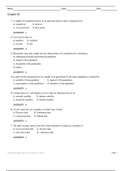
-
Chapter 2: Business Analytics_ Data Analysis _ Decision Making 5th Edition Albright
- Exam (elaborations) • 25 pages • 2020
-
- £8.19
- 1x sold
- + learn more
1. A sample of a population taken at one particular point in time is categorized as: a. categorical b. discrete c. cross-sectional d. time-series c 2. Excel stores dates as a. numbers b. variables c. records d. text a 3. Researchers may gain insight into the characteristics of a population by examining a a. mathematical model describing the population b. sample of the population c. description of the population d. replica b 4. In order for the characteristics of a sample to be generalized to ...
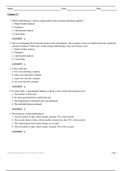
-
Chapter 17: Business Analytics_ Data Analysis _ Decision Making 5th Edition Albright
- Exam (elaborations) • 5 pages • 2020
-
- £7.37
- 3x sold
- + learn more
1. Which methodology is used to group products that customers purchase together? a. Market basket analysis b. Prediction c. Classification analysis d. Forecasting 2. Mya is investigating the factors that impact soda consumption. She examines a host of variables that help explain the amount consumed. Which type of data mining methodology is she most likely to use? a. Market basket analysis b. Prediction c. Classification analysis d. Forecasting 3. A facts table has: a. few rows and many columns...

Study stress? For sellers on Stuvia, these are actually golden times. KA-CHING! Earn from your revision notes too and start uploading now. Discover all about earning on Stuvia
